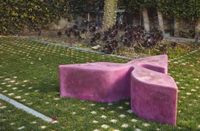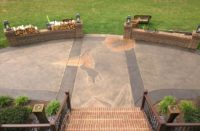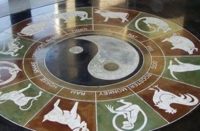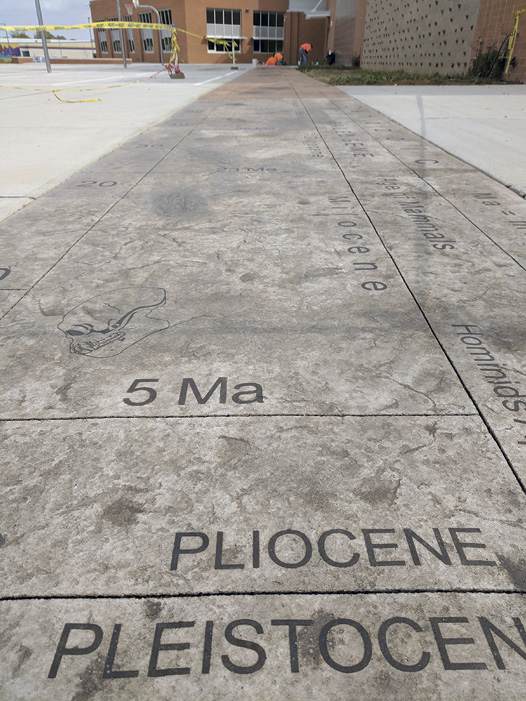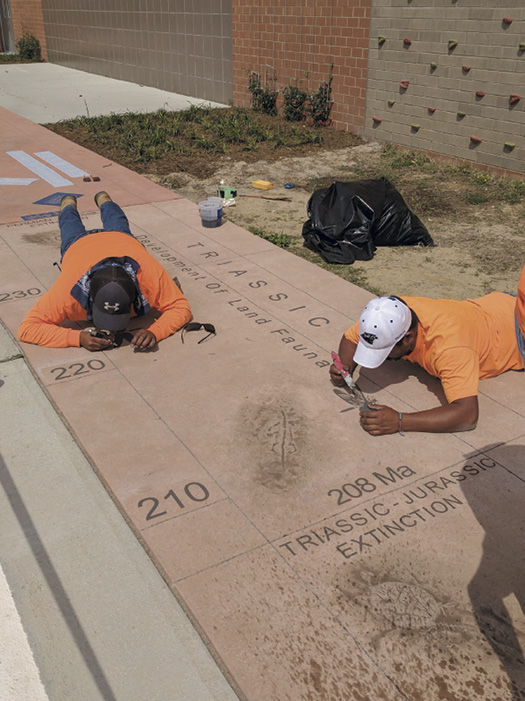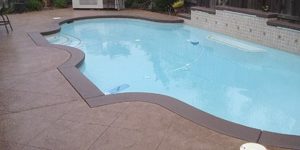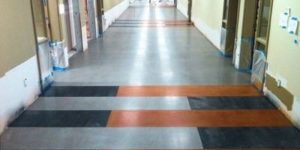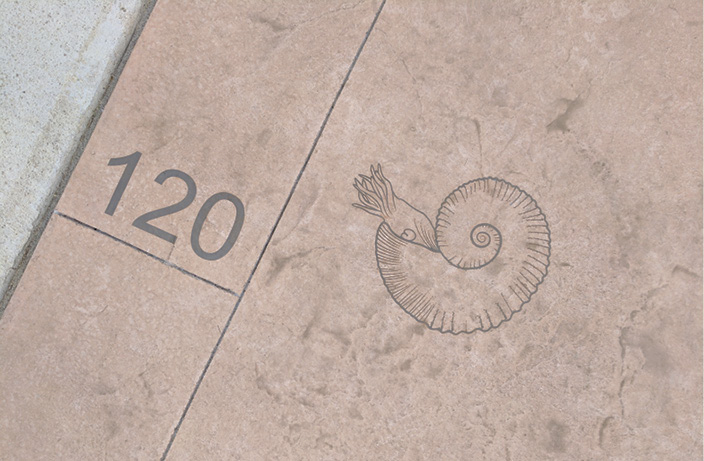
Old Donation School in Virginia Beach, Virginia, is decidedly forward-looking in its educational mission, complete with facility design approaches geared to innovative learning concepts.
One of the school’s design features, however, offers a view in the other direction — to the long-ago past, as measured in millions and billions of years.
This design element is the school’s Geologic Time Walk, a collaborative construction feature conceived and built by Virginia Beach City Public Schools, RRMM Architects, faculty members and general contractor McKenzie Construction Corp.
A major supporting role, however, was played by Carolina Bomanite Corp., the decorative and architectural concrete contractor that installed and served as a key design participant for the Geologic Time Walk. Carolina Bomanite recommended materials and design details, such as stamping tools, and provided answers to various design challenges that took the time walk from abstract design concept to built reality.
“These kinds of projects are what define the level of expertise in what we offer and bring to clients,” says John Fletcher, Carolina Bomanite president, of the time walk. “We do the extraordinary, not the ordinary.”
Not your mom and dad’s school
Old Donation School, completed in 2017, replaces facilities for three “gifted learner” programs operated by VBCPS. The $63 million, 225,000-square-foot facility uses “circulation space” as “learning space,” with small collaboration rooms in between classrooms called “think tanks” for smaller independent groups. Outdoor classrooms also provide learning spaces.
Much of the school’s curriculum focuses on the geography and ecology of the Chesapeake Bay region of Virginia, Maryland and North Carolina. The region’s concern with storm water runoff and rising sea levels are reflected in the curriculum’s emphasis on ecosystems, aquatic and marine life, and environmental sciences.
The school is designed to achieve LEED Gold certification, with advanced HVAC systems, LED lighting, extensive daylighting, collecting rainwater to flush toilets, and other “green” design elements.
“Students and staff asked for colorful, wide-open spaces and lots of daylight, so that’s what we gave them,” says Rob Berz, RRMM’s design architect for the school.
Jurassic walk and more
On the Geologic Time Walk, one can find replicas of fossil remnants of the various eras and epochs of the Earth’s past. There’s the Mesozoic Era, for example, some 252 million to 66 million years ago. If that term doesn’t ring a bell, surely you’ve heard of the Jurassic, made famous by Hollywood through a series of films with immense special effects. The Jurassic period is the portion of the Mesozoic when the great dinosaurs dominated the planet.
The Geologic Time Walk dramatizes the mind-boggling size and scope of geologic time, and the miniscule place human history occupies in the scale of Earth’s existence.
The earliest modern humans are thought to have emerged some 200,000 years ago, during the current geologic era, the Cenozoic. The Precambrian eon of geologic time, meanwhile, is dated to when Earth was forming some 4.6 billion years ago. Along the way from coalesced mass orbiting the Sun those many years ago, to earliest life forms, to the age of reptiles and age of mammals, to the dawn of man, the succession of geologic periods etched a fossil record documenting the genesis and evolution of life forms both extinct and existing.
So, the Geologic Time Walk task facing Carolina Bomanite and the school design team was downright dinosaur size in scope of design and installation challenge, if not in sheer physical size.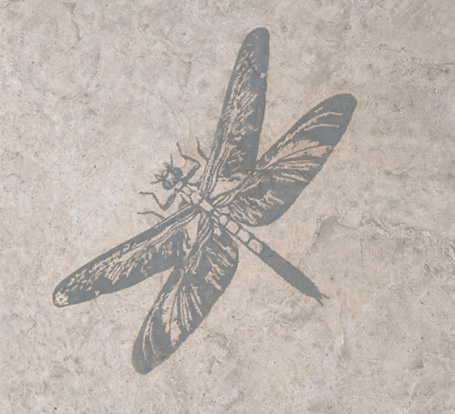
Concept to concrete
The Geologic Time Walk came to the attention of Carolina Bomanite in late 2013 or 2014, when architects for the Old Donation School project contacted the company. After talking to suppliers of concrete stamps and artwork templates, Fletcher got back to the architects on what was possible in delivering on the design concept.
He submitted samples of time walk sections that included fossils created with stamp tools and acid etching, concrete surface textures and integrally colored concrete.
For fossil imprints, Carolina Bomanite enlisted the craftsmanship of Matcrete Decorative Concrete Products and Surface Gel Tek. Matcrete supplied a variety of stamp tools from its Fossil Effects product line. Surface Gel Tek’s role was significantly more complex, as the company produced customized templates of fossil images, words and numbers to be etched into the concrete using Surface Gel Tek’s gelled-acid etching process.
Marching forward through time
For Carolina Bomanite, installing the time walk presented the challenges of skilled concrete construction, geometric precision and artistic craftsmanship. Fletcher went with a relatively small crew, recognizing the need for tight management of all the processes involved.
In the spring of 2017, “Wind was the biggest issue,” Fletcher says. “It was an open area, and unusually windy.” This put the crew to the test in ensuring consistency in the pours.
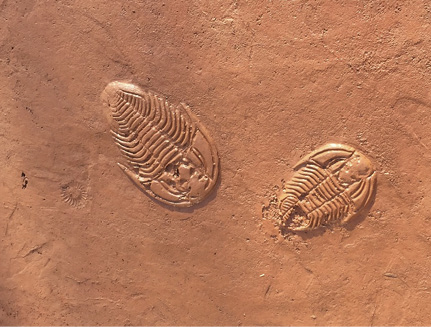 Concrete with integral colors was used, with each color of the walkway indicating a different span of geologic time. The colors from Scofield, most of which have since been discontinued, were Sombrero Buff, Navajo Red, Roman Tile, Surrey Beige and Moonlight Gray.
Concrete with integral colors was used, with each color of the walkway indicating a different span of geologic time. The colors from Scofield, most of which have since been discontinued, were Sombrero Buff, Navajo Red, Roman Tile, Surrey Beige and Moonlight Gray.
The entire walkway surface was textured with a Bomanite slate mat. To lend authenticity to the visuals, other textures were matched with individual fossil images and used on the concrete surface adjacent to the fossils. The texture and fossil stamps from Matcrete were placed as the sections of walkway were poured.
The Carolina Bomanite crew laid out the design for each section of walkway with precise measurements in the surface for saw cuts, fossils, wording and numbers. “Logistics were everything,” Fletcher says. “It required a concerted effort. Everyone had to be on the same page.”
The fossil templates from Surface Gel Tek were “sticky” self-adhesive elements attached to the hardened concrete. Here, acid gel was used to etch the surface prior to a secondary coloring process using Bomanite Micro-Top.
Gelled acid and concrete art
The gelled-acid Flattoo process from Surface Gel Tek was used for much of the walkway’s fossil artwork and geologic timeline elements. For the project, owner Tamryn Doolan created custom vinyl adhesive templates based on images of fossils specified by the Old Donation design team. Doolan also created templates for the geologic terms and the numbers indicating years of various geologic periods.
To create these elements, Doolan employs a software graphics program that creates multidimensional templates that can be used for acid etching and coloring concrete. Following design-team approval of the artwork, a vinyl adhesive template is produced and shipped to the contractor.
To create the intended image, the template is “weeded” before it’s placed on the surface – meaning parts of the template are removed to expose areas of the concrete that will be acid-etched for color contrast, or etched and colored using products such as dyes, stains or acrylics for more dramatic coloring. Areas that remain covered by the template aren’t etched and colored.
The acid etching opens up the concrete’s pores, allowing the color to penetrate and permanently color the concrete. “It’s very much like tattooing,” Doolan says. Acetone dyes are typically applied without prior acid etching, as the acetone penetrates the concrete on its own.
Doolan emphasizes how important communication is when it comes to matching process details with color specifications and other project parameters. “We are the contractor’s art department, in that we understand graphics that work with concrete,” she says. “We take the fear of art out of the equation.”
School as teaching tool
Tim Cole, VBCPS sustainability officer, says LEED and sustainable design have been part of the district’s mission for new facilities for some time. Old Donation is the ninth LEED design project for the district, and these facilities incorporate features that capture rainwater, emphasize daylighting, and use geothermal heating and cooling, among other sustainable-design functions.
“What we’ve gotten better at is designing the school to also serve as a teaching tool,” Cole says. Old Donation’s atrium floor — a terrazzo installation — is a scale replica of the Chesapeake Bay watershed, depicting the region’s geography and ecology and serving to illustrate the challenges the low-lying region faces from pollution, surging storm water and rising sea levels.
The Geologic Time Walk also serves the school’s teaching-tool aspirations in a big way — millions of years of planet Earth’s history in a brief stroll from parking lot to school.
Project at a Glance
Client: Geologic Time Walk, Old Donation School, Virginia Beach, Virginia
Owner: Virginia Beach City Public Schools
Decorative / Architectural concrete contractor: Carolina Bomanite Corp., Charlotte, North Carolina | www.carolinabomanite.com
General Contractor: McKenzie Construction Corp., Virginia Beach, Virginia
Architect: Rob Berz, RRMM Architects, Chesapeake, Virginia
Concrete Mix Supplier: Capital Concrete Inc., Norfolk, Virginia
Scope of project: Creating a Geometric Time Walk including stamping, texturing, etching and coloring customized templates of fossil images, words and numbers
Most challenging aspect: Crew had to be highly skilled and knowledgeable in the use of customized templates for gelled-acid etching process; placement, stamping, acid etching and texturing of decorative concrete had to be very precise
Products used: Scofield integral colors, Matcrete Decorative Concrete Products stamps, Bomanite Imprint Systems texture skins, Bomanite Micro-Top, Surface Gel Tek customized templates
